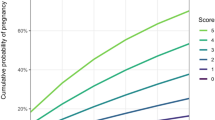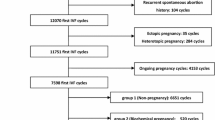Abstract
Purpose
This study aimed at evaluating the value of uterine biophysical profile (UBP) scoring to predict the pregnancy rate after IUI.
Methods
This prospective study was carried out on 85 women who were referred to our tertiary teaching center with infertility of male factor or unknown etiology infertility in 2018. To measure the uterine biophysical criteria, transvaginal ultrasonography (TVS) was performed on the day of beta-human chorionic gonadotropin (B-hCG) injection, and the results were evaluated based on positive B-hCG.
Results
85 patients were included with a mean age of 30 years; of those 12 (14.1%) were able to conceive. UBP (p = 0.151) and it’s parameters (including endometrial thickness, number of endometrial layers, myometrial echogenicity, uterine artery pulsatility index, myometrial blood flow internal to arcuate vessels, endometrial blood flow in the third zone of endometrium, myometrial contraction frequency, and ovarian follicle (OF) size [p = 0.05, 0.89, 0.59, 0.79, 1, 1, 0.59, and 0.77, respectively]) were not significantly associated with pregnancy rate. 91.7% of the cases with positive pregnancy test results, had a UBP score of > 13; however, UBP score was not meaningfully associated with IUI treatment success rate (p = 0.15).
Conclusions
UBP scoring system seems to need more data for external validation, or it might require modifications before implementation, as it may cause false reassurance.

Similar content being viewed by others
Abbreviations
- ART:
-
Assisted Reproductive Technology
- B-hCG:
-
Beta-Human Chorionic Gonadotropin
- EBF:
-
Endometrial Blood Flow
- EMP:
-
Endometrial Pattern
- EMT:
-
Endometrial Thickness
- IUI:
-
Intrauterine Insemination
- MBF:
-
Myometrial Blood Flow
- MCF:
-
Myometrial Contraction Frequency
- OF:
-
Ovarian Follicle
- PI:
-
Pulsatility Index
- TVS:
-
Transvaginal Ultrasonography
- UA-PI:
-
Pulsatility Index of Uterine Artery
- UBP:
-
Uterine Biophysical Profile
References
Boivin J, Bunting L, Collins JA, Nygren KG (2007) International estimates of infertility prevalence and treatment-seeking: potential need and demand for infertility medical care. Hum Reprod 22(6):1506–1512
Lindsay TJ, Vitrikas K (2015) Evaluation and treatment of infertility. Am Fam Phys 91(5):308–314
Thoma ME, McLain AC, Louis JF, King RB, Trumble AC, Sundaram R et al (2013) Prevalence of infertility in the United States as estimated by the current duration approach and a traditional constructed approach. Fertil Steril 99(5):1324–2311
Cramer DW, Walker AM, Schiff I (1979) Statistical methods in evaluating the outcome of infertility therapy. Fertil Steril 32(1):80–86
Vahidi S, Ardalan A, Mohammad K (2009) Prevalence of primary infertility in the Islamic Republic of Iran in 2004–2005. Asia Pac J Public Health 21(3):287–293
Evers JL (2002) Female subfertility. The Lancet 360(9327):151–159
Jumayev I, Harun-Or-Rashid M, Rustamov O, Zakirova N, Kasuya H, Sakamoto J (2012) Social correlates of female infertility in Uzbekistan. Nagoya J Med Sci 74(3–4):273
Gnoth C, Maxrath B, Skonieczny T, Friol K, Godehardt E, Tigges J (2011) Final ART success rates: a 10 years survey. Hum Reprod 26(8):2239–2246
Yaman C, Ebner T, Sommergruber M, Pölz W, Tews G (2000) Role of three-dimensional ultrasonographic measurement of endometrium volume as a predictor of pregnancy outcome in an IVF-ET program: a preliminary study. Fertil Steril 74(4):797–801
Direkvand-Moghadam A, Sayehmiri K, Delpisheh A (2014) The global trend of infertility: an original review and meta-analysis. Int J Epidemiol Res 1(1):35–43
Ajossa S, Melis GB, Cianci A, Coccia ME, Fulghesu AM, Giuffrida G et al (1997) An open multicenter study to compare the efficacy of intraperitoneal insemination and intrauterine insemination following multiple follicular development as treatment for unexplained infertility. J Assist Reprod Genet 14(1):15–20
Armstrong S, Akande V (2013) What is the best treatment option for infertile women aged 40 and over? J Assist Reprod Genet 30(5):667–671
Kamali M, Kashfi F, Baghestani A, Kashani H, Tavajohi S, Amirchaghmaghi E (2011) The epidemiologic survey on causes of infertility in patients referred to Royan Institute. Med J Tabriz Univ Med Sci 28(1):103–105
Razzak A, Wais S (2002) The infertile couple: a cohort study in Duhok, Iraq. EMHJ-Eastern Mediterr Health Journal 8(2–3):234–238
Ivanovski M (2012) The role of ultrasound in the evaluation of endometrial receptivity following assisted reproductive treatments. In: In vitro fertilization–innovative clinical and laboratory aspects. https://doi.org/10.5772/38592
Applebaum M (1995) The uterine biophysical profile. Ultrasound Obstet Gynecol 5(1):67–68
Navinchandra RN, Shankar ST, Kamath MG, Devdas SP, Vineela P (2016) Relationship between uterine scoring system for reproduction and pregnancy in controlled ovarian stimulation-intrauterine insemination cycles. IVF Lite 3(3):115
Vichinsartvichai P, Siriphadung S, Traipak K, Promrungrueng P, Manolertthewan C, Ratchanon S (2015) The influence of women age and successfulness of intrauterine insemination (IUI) cycles. J Med Assoc Thai 98(9):833–838
Zaidi J, Campbell S, Pittrof R, Tan S (1995) Endometrial thickness, morphology, vascular penetration and velocimetry in predicting implantation in an in vitro fertilization program. Ultrasound Obstet Gynecol 6(3):191–198
Malhotra N, Malhotra J, Malhotra N, Rao J, Mishra N, Kurjak A et al (2010) Endometrial receptivity and scoring for prediction of implantation and newer markers. Donald Sch Ultra-sound Obstet Gynecol 4:439–446
Sahakyan M, Harlow BL, Hornstein MD (1999) Influence of age, diagnosis, and cycle number on pregnancy rates with gonadotropin-induced controlled ovarian hyperstimulation and intrauterine insemination. Fertil Steril 72(3):500–504
Gupta P, Chandra S, Kaushik A, Jain PK (2014) Evaluation of uterine biophysical profile and to assess its role in predicting conception among unexplained primary infertility patients. Indian J Community Health 26(4):401–405
Thakur M, Dhaliwal L, Suri V, Gainder S (2010) Evaluation of uterine biophysical profile, an ultrasonographic uterine scoring system, in unexplained infertility and to assess its prognostic value in predicting pregnancy. J Minim Invasive Gynecol 17(6):S48
Khan MS, Shaikh A, Ratnani R (2016) Ultrasonography and Doppler study to predict uterine receptivity in infertile patients undergoing embryo transfer. J Obstet Gynecol India 66(1):377–382
Masrour MJ, Shafaie A, Yoonesi L, Aerabsheibani H, Masrour SJ (2016) Evaluating endometrial thickness and vascular ultrasound pattern and pregnancy outcomes inintrauterine insemination cycle. Asian JPharm Res Health Care 8(1):24–29
Tsai H-D, Chang C-C, Hsieh Y-Y, Lee C-C, Lo H-Y (2000) Artificial insemination. Role of endometrial thickness and pattern, of vascular impedance of the spiral and uterine arteries, and of the dominant follicle. J Reprod Med 45(3):195–200
Weiss N, Van Vliet M, Limpens J, Hompes P, Lambalk C, Mochtar M et al (2017) Endometrial thickness in women undergoing IUI with ovarian stimulation. How thick is too thin? A systematic review and meta-analysis. Hum Reprod 32(5):1009–1018
Kumari M, Singh K, Bharti G, Kumar V, Umakant P, Suman SK (2017) Biophysical Scoring of the Endometrium and Intrauterine Insemination Outcome in the Patient with Infertility. Int J Sci Study 5(2):120–124
Liu Y, Xiang YY, Chan C (2019) The association between endometrial thickness and pregnancy outcome in gonadotropin-stimulated intrauterine insemination cycles. Reprod Biol Endocrinol 17(1):1–8
Kim A, Lee JY, Ji YI, Lee HH, Lee ES, Kim HY et al (2015) Do endometrial movements affect the achievement of pregnancy during intrauterine insemination? Int J Fertil Steril 8(4):399
Prasad S, Goyal R, Kumar Y, Nayar P, Hajela S, Kumaran A et al (2017) The relationship between uterine artery two-dimensional color Doppler measurement and pregnancy outcome: a prospective observational study. J Reprod Infertil 18(2):251
Swierkowski-Blanchard N, Boitrelle F, Alter L, Selva J, Quibel T, Torre A (2017) Uterine contractility and elastography as prognostic factors for pregnancy after intrauterine insemination. Fertil Steril 107(4):961–8. e3
Acknowledgements
The authors would like to thank the Clinical Research Development Center of Imam Reza Hospital for consulting services.
Author information
Authors and Affiliations
Corresponding author
Ethics declarations
Funding
Not applicable.
Conflict of interest
The authors declare no conflicts of interest.
Ethics approval and consent to participate
This work has been approved by the Kermanshah University of Medical Science (KUMS) Ethical Committee Board. Informed consents were obtained from all participants.
Consent to publication
Not applicable.
Availability of data and material
The datasets used and analysed during the current study are available from the corresponding author on reasonable request.
Authors’ contributions
NF, TF and JA provided direction and guidance throughout the preparation of this manuscript. NF, PBK and ML collected the data. NF, PBK and JA analyzed and interpreted data and drafted the manuscript. All authors reviewed the manuscript and made significant revisions and approved the final version of the manuscript draft.
Additional information
Publisher's Note
Springer Nature remains neutral with regard to jurisdictional claims in published maps and institutional affiliations.
Rights and permissions
About this article
Cite this article
Farshchian, N., Fakheri, T., Bahrami Kamangar, P. et al. Pregnancy rate in intrauterine insemination, is uterine biophysical profile of predictive value? A prospective study. J Ultrasound 25, 949–955 (2022). https://doi.org/10.1007/s40477-022-00670-7
Received:
Accepted:
Published:
Issue Date:
DOI: https://doi.org/10.1007/s40477-022-00670-7




